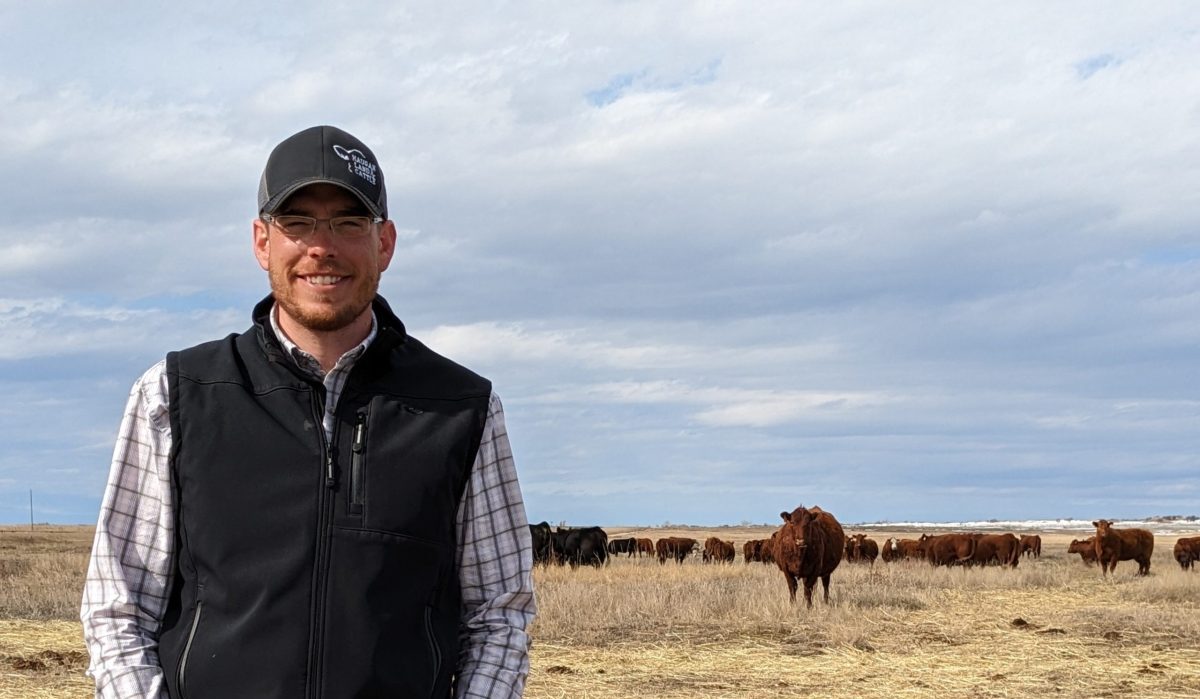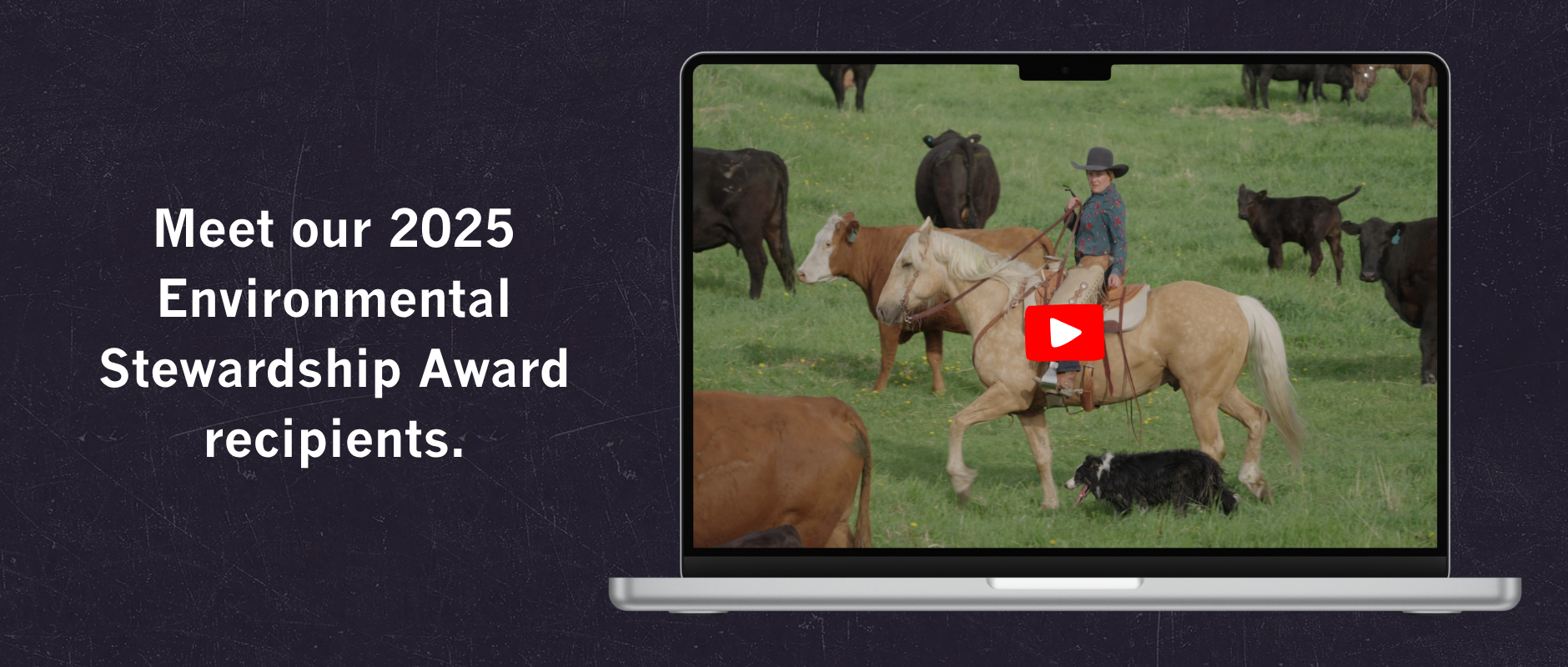AB Direct - Steers
Rail: 491.50-503.50 FOB feedlot (last week)
AB Direct - Heifers
Rail: 491.50-503.50 FOB feedlot (last week)
US Trade- Steers
Rail: 355.00-360.00 (IA, NE) last week
US Trade - Heifers
Rail: 355.00-360.00 (IA, NE) last week
Canadian Dollar
0.31

New year, new chair, new perspective
Stepping into a leadership role in any organization these days is no small challenge. Doing so in a business more than a century old, steeped in tradition and lifestyle, while facing modern challenges of economics and diverse views, could be extra daunting. But it is a role Brodie Haugan has thoughtfully taken on as the chair of the Alberta Beef Producers.
Even though at 32, he bears the title of the youngest-ever ABP chair, Haugan has already logged eight years of experience in the organization. Becoming part of the group seemed like a natural progression after his experience in the Canadian Cattle Young Leaders mentorship program, and then the Canadian Cattle Youth Council.
“It just opened my eyes to seeing there’s so much more that’s happening,” recalls Haugan, who ranches with his wife Melissa Lemmer, and his folks Byron and Sheila, in the very southeastern corner of the province, at Orion.
Haugan soon realized the best way to find answers to questions and have an influence on issues was to get involved.
“So many times you just complain to your neighbours and nothing changes. It’s hard to understand how you actually make changes, and the proper people and the mechanisms that are in place to really drive change. That’s been my passion. I’ve learned a lot of those connections now, and as a young person, I see value to being in those positions, and at those meetings.
“At the producer meetings we go to and a lot of the events, we’re seeing that next generation trying to make a go of it, and they’re looking to ourselves for people who are trying to do the same.”
Both Haugan and ABP General Manager Brad Dubeau see this as a good time for the organization to look in the mirror.
“Within ABP right now, we’re definitely taking an internal look to saying what does an organization look like for the future, and everything is on the table,” emphasizes Haugan.
“We all recognized we had to be more responsive to producers as a commission,” says Dubeau. “So we set out two years ago on this path, finding new ways to connect with all the different demographics within the beef industry. Brodie was a part of that path, and now we’re diving deeper.”
Under development is a document that will serve as a conversation starter for the upcoming feedback sessions. From there, information gathered will be refined and sent back out next year, so any substantial changes can be in place before the next ABP plan review with government.
“We want to hear from producers and other organizations what a successful commission looks like,” says Dubeau. “In the end, we really want a beef industry commission that serves producers well. We’re under no illusion that everyone will agree on every issue, but check-off contributors need to feel confident the commission is providing leadership for the beef industry, and advocating on their behalf, so they can be as successful as possible in their operations.”
While current beef market factors seem to only be pointing upwards, like so many experienced producers, Haugan is cautious about jumping up and down quite yet. He realizes the need to do more with less and bigger outfits required for economic viability are still hurdles facing the cattle business, not to mention competition for land base with grain production or urban expansion.
Haugan is closely watching the rollout of a price and production insurance program with federal support for cow-calf producers in the U.S. this summer, as part of their drive for overall food security.
“Brodie brings that perspective of a young person trying to make a go in the cattle industry, both economically and environmentally sustainably,” notes Dubeau. “It bodes well for what we’re trying to do at ABP, because we need our industry to be competitive against other commodities in agriculture. We’re working towards it and appreciate AFSC’s efforts to listen and look at different business risk management tools.
“We’re just looking for tools that producers, at each one of those levels in producing beef, can engage with to protect their investments, so that our youth feel like there’s a way to be successful in the event of a downturn that is out of their control. That’s part of our job – to advocate to make these programs work when they’re needed.”
As the striving continues for ABP to reach a fully funded position, there are some encouraging signs in reduced refund requests.
“In the last two years, transparency and communication, and understanding of where the money actually goes, has really triggered some people to give it a second thought,” says Haugan. “Continuing work towards a fully funded industry with one voice, with everyone at the table, for the better good of the industry as a whole, is my task.”
Dubeau takes that challenge very seriously as well, focusing on bridges while dealing with a broad range of issues often impacting sectors in very different ways.
“ABP continues to strive to build relationships with the membership organizations because we all need to work together to represent beef producers in this province,” he says.
After three years of punishing drought on his home range, Haugan is encouraged the long winter brought a replenishment of moisture to green up the shortgrass country and boost optimism on all fronts.
“It has been many years since we’ve had a spring that looks this good. We can still see the marks from the drought, but we are hopeful a couple of wet years and some reduced grazing will heal the landscape.”
Improving the economic viability of ranching remains paramount for Haugan, so he’s willing to invest time off the ranch leading a group he believes can help move the target closer.
“I really want to see if a young guy chooses to be a rancher, or in the beef industry, he can make a profit and have a good lifestyle doing what he loves. That’s my number-one goal.”
This article was first published in Volume 3 Issue 2 of ABP Magazine (June 2023). Watch for more digital content from the magazine on ABP Daily.

